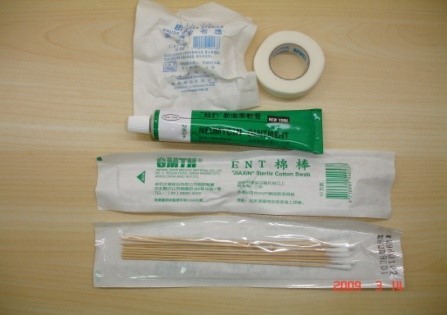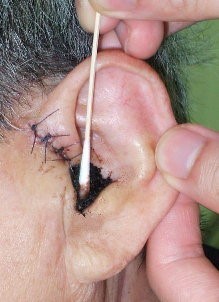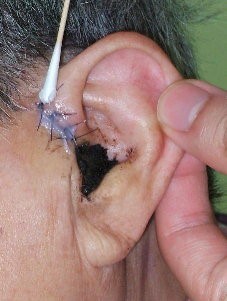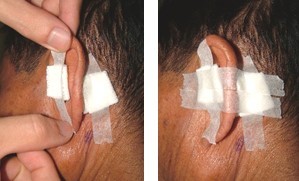【Major points】
- Please prevent the wound from water to keep it dry and clean after surgery.
- The sponge-like substance using to protect the repaired eardrum needs to be placed in the ear for two to four weeks. It will be taken out by doctor during your next visit.
- After surgery, please be careful not to get cold or staying in a sweltering environment. Permission is required for any water activity.
What is the microscopic ear surgery?
The microscopic ear surgery is the performance of series operations in ears by using endoscopic or microscopic techniques. The view of the area of surgery is enlarged using a microscope.
The microscopic ear surgery is the performance of series operations in ears by using endoscopic or microscopic techniques. The view of the area of surgery is enlarged using a microscope.
Purpose of the operation:
- Microscopic surgery such as tympanoplasty and mastoidectomy is used for treating patients with chronic otitis media, eardrum perforation, cholesteatoma, ossicles defect and sclerosis. Those diseases would cause some discomforts, for instance, otorrhea, hearing imperatives or ear pain. The surgeries, including membrane repairment and ossicles transplantation, are intend to maintain good air conduction, improve hearing, and prevent tympanum from infection.
- Tympanoplasty is used for patients with chronic middle ear infections. Mastoidectomy is a procedure to clean the mastoid in the middle ear.
- The major advantage of microscopic surgery is smaller wound area with less pain.
Pre-operative preparation:
- Preoperative examination, such as an electrocardiogram, a chest x-ray and blood tests, will be conducted the day before surgery.
- Doctor will officially inform patient the surgical procedure as well as the surgical risks. Please fill out consent forms related to the operation and anesthesia procedure.
- Inform the medical staff if you are using any medications or anticoagulants.
- Shampoo the day before surgery.
- Please follow the instructions from the medical staff either fasting after midnight on the surgery day or after finishing your breakfast. During fasting, do not eat any food or drink water except medications permitted by doctor. Mouth rinse is allowed.
- On the surgery day, change your clothes and underwear to a surgical gown and hospital pants. Please do not make up and do remove all accessories, such as dentures, contact lenses and watch, and nail polish.
- Urinate before going to the operation room.
Post-operative care:
- Dietary:
- After general anesthesia: Fast for another 4-6 hours. After local anesthesia: Drink some water first. If you do not experience cough or any discomfort, then you could have a regular diet.
- Because your chorda tympani nerve might be cut in the surgery due to illness, which is as notice in the consent form, you might suffer from abnormal taste sensation. It would recover in about 3-6 months.
- Wound care:
- While lying on bed, lift your head to about 30 degrees. Do not wear glasses in case of pressing injury.
- The wound would cover with the usage of compression bandages. If the bandage is too tight, dislocated or oozes, please inform medical staff. To prevent the wound from bleeding or swelling, do not remove the bandage voluntarily.One or two days later will be removed by doctor.
- Use a shower cap while showering to prevent water from entering the ear canal.
- A sponge-like substance with antibiotics might be placed in the ear canal to protect the repaired eardrum. Thus, your hearing function might be temporarily affected.
- After two to four weeks, the sponge-like substance will be removed by doctor. Please do not remove it by yourself.
- Other considerations:
- After the surgery, you might suffer from dizziness or nausea or vomiting.
- For your safety, please walk slowly. It is suggested to have a family member or any other person to be with you to prevent falling.
- If the following conditions occur, please feel free to inform the medical staff anytime you need:
- Nausea and vomiting are the common narcotic side effects. The intravenous fluid would be helpful to enhance drug metabolism during fasting. The discomfort feeling could slightly relieve through antiemetic drugs or listening to music.
- If suffering from pain or a throbbing sensation, the doctor will prescribe medications to help you to control the pain.
- The sponge-like substance which is placed to protect the repaired eardrum might make you feel or hear a pulse-like throbbing sound, steaming or ringing sound.
- If you experience hearing loss suddenly, please inform the medical staff.
Self-care at home:
- Daily life precautions:
- Please be careful not to get cold. Avoid contact with persons suffering from upper respiratory tract infections, such as a cold,flu,tonsillitis or laryngitis.
- Till the sponge-like substance is taken out, please shampoo your hair less frequently. Please prevent the wound and the sponge-like substance from water when showering.
- Minimize the chance to stay in a sweltering environment.
- Please get doctor’s approval before doing any water activity.
- Please avoid coughing hardly and blowing nose. When sneezing, please open your mouth to keep the pressure balanced in the middle ear.
- Wound dressing procedures:
- Wash your hands.
- Supplies preparation: 1 x 1 inch germ-free gauzes, germ-free cotton swabs, ½ inch fastening tapes and antibiotic ointment (Figure 1).

Figure 1 - Tear off old medicated dressing.
- You need to be in front of a mirror to change your dressing. Use a cotton swab to rub the sponge-like substance placed at the opening of the ear canal until it is dry. Gently push the sponge-like substance if it is falling off from the ear canal (Figure 2).

Figure 2 - Rub a small amount of antibiotic ointment with a germ-free cotton swab on the stitches (Figure 3).

Figure 3 - Use one 1 x 1 inch germ-free gauze to cover up the opening of the ear canal and one on the wound. Secure them with tapes (Figure 4, Figure 5).

Figure 4
Figure 5 - When showering, please prevent the ear canal from spilling water to keep the wound and dressing area clean and dry.
- After discharged, the dressing needs to be changed once a day until the sponge-like substance is removed by doctor.
- After discharge, do make a return visit at the outpatient department.
References
- Dundar, R., Iynen, I., & Buyruk, A. (2022). Different approach for surgery of stapes: Comparison microscopic and endoscopic approach. American Journal of Otolaryngology, 43(1), 103242. https://doi.org/10.1016/j.amjoto.2021.103242
- Elvir-Lazo, O. L., White, P. F., Yumul, R., & Cruz Eng, H. (2020). Management strategies for the treatment and prevention of postoperative/postdischarge nausea and vomiting: an updated review. F1000Research, 9, F1000 Faculty Rev-983. https://doi.org/10.12688/f1000research.21832.1
- Lau, K. L., Tustin, H., & Stafford, F. (2022). Sacrifice of the chorda tympani nerve during middle ear surgery can lead to resolution of dysgeusia. The Journal of Laryngology & Otology, 1–7. https://doi.org/10.1017/S0022215121004576
- Li, B., Zhou, L., Wang, M., Wang, Y., & Zou, J. (2021). Endoscopic versus microscopic surgery for treatment of middle ear cholesteatoma: A systematic review and meta-analysis. American Journal of Otolaryngology, 42(2), 102451. https://doi.org/10.1016/j.amjoto.2020.102451
Quiz
Please answer the following questions:
Nursing Instruction Satisfaction
Please log in to rate
- Location
-
- Category
- Surgery / Procedure

